Physical Address
304 North Cardinal St.
Dorchester Center, MA 02124
This chapter considers abnormalities of the pulmonary veins, in particular their anomalous connections to the systemic venous system. The variant of partially anomalous pulmonary venous connection associated with the sinus venosus interatrial communication is described in detail. The anomalous pulmonary venous connections so commonly associated with isomerism of the atrial appendages are mentioned in this chapter but are discussed more fully in Chapter 26 , not least because of the particular problems of nomenclature that arise in the setting of isomerism. Although division of the morphologically left atrium was, in the past, considered a pulmonary venous anomaly, this lesion, along with division of the morphologically right atrium, is covered in Chapter 30 .
At the turn of the seventeenth century Wilson described a “monstrous formation of the heart in which the superior caval vein was joined by a trunk formed by two large veins coming out of the lungs.” We now know that the various forms of such totally anomalous pulmonary venous connections (TAPVCs) in the absence of isomerism of the atrial appendages or visceral heterotaxy accounted for 1 out of every 40 patients registered in the New England Regional Infant Cardiac Program. As such, the entity ranked 12th in frequency and occurred once in 17,000 live births. In the Baltimore-Washington Infant Study, the malformation was encountered less commonly, accounting for 1.5% of all patients with a cardiovascular malformation and being seen once in 14,700 live births. TAPVC is known to be part of the Holt-Oram, Klippel-Feil, phocomelia, and Schachenmann syndromes. It is more difficult to establish the incidence of partially anomalous pulmonary venous connection, since anomalous connection of a solitary vein ( Fig. 28.1 ) may be unrecognized either in life or death. Such anomalies have been reported in about 1 in 200 routine postmortems. Furthermore, in an extensive investigation based on surgical and autopsy experience, seven-tenths of all cases of anomalous pulmonary venous connection were found to be of the partial variety, although this review included patients with isomerism of the atrial appendages.
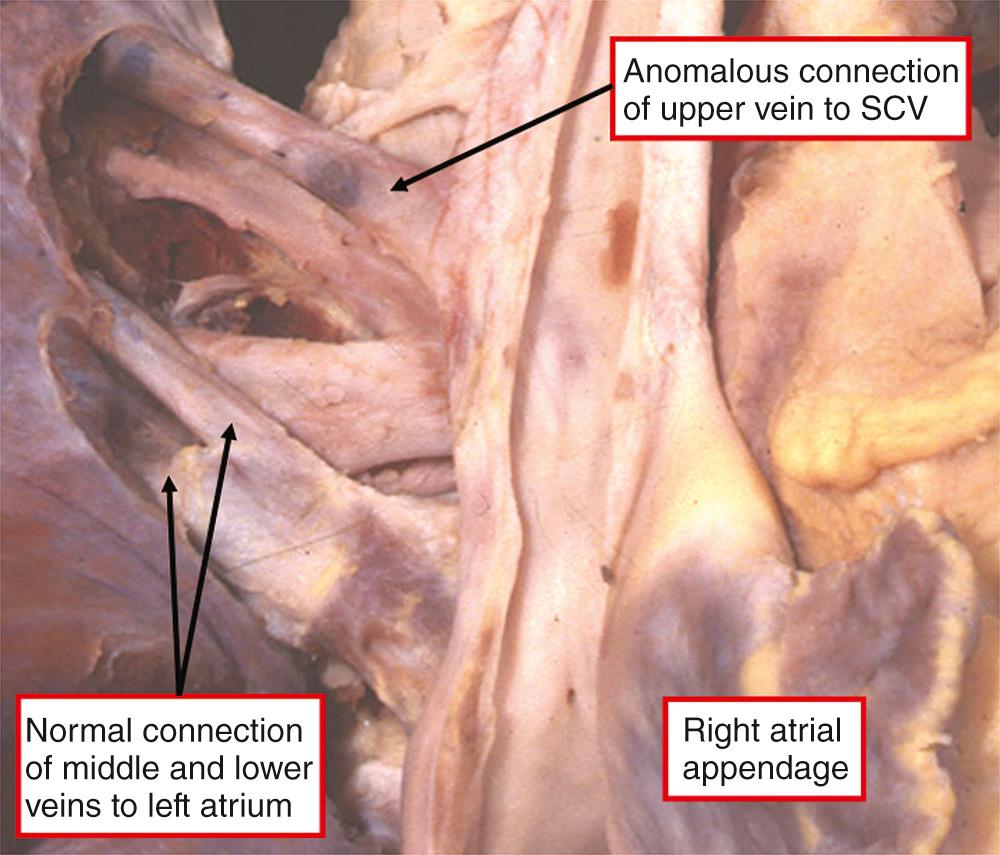
Earlier reports on TAPVC stressed the preponderance of males in the setting of infradiaphragmatic drainage, with an equal mix of gender in the remaining types. In those recorded in the New England Regional Infant Cardiac Program, however, two-thirds with supracardiac and cardiac connections were males, whereas it was the infradiaphragmatic variant that showed an equal mix of genders. As with so many lesions, there are some examples of familial clustering, with one report suggesting autosomal dominant inheritance. Some evidence suggesting maternal exposure during the first 3 months of pregnancy to teratogens emerged from the Baltimore-Washington Infant Study. Reanalysis of that dataset in 2004 found the association with maternal exposures inconclusive but identified a link between totally anomalous connection and paternal exposure to lead prior to conception.
Anomalous pulmonary connections take various forms and show several important clinical features. The first important feature is the proportion of the pulmonary venous drainage that is connected to sites other than the morphologically left atrium. This can be a solitary pulmonary vein, all of the veins from one lung, or the entirety of the pulmonary venous drainage ( Fig. 28.2 ). Combinations are also possible when all veins do not drain anomalously, so although rare, it can be possible for all of the drainage from one lung and a solitary vein from the other lung to be connected to sites other than the morphologically left atrium. Once it has been established that a pulmonary vein or pulmonary veins are draining anomalously, it is of equal importance to determine the site of drainage and whether all the veins drain to the same site. It is necessary to seek stenotic areas or regions along the route of anomalous drainage. It is also necessary to establish whether the anomalous pulmonary venous connection is an isolated malformation or part of a more complex anomaly and whether there are associated structural malformations of the pulmonary vasculature.
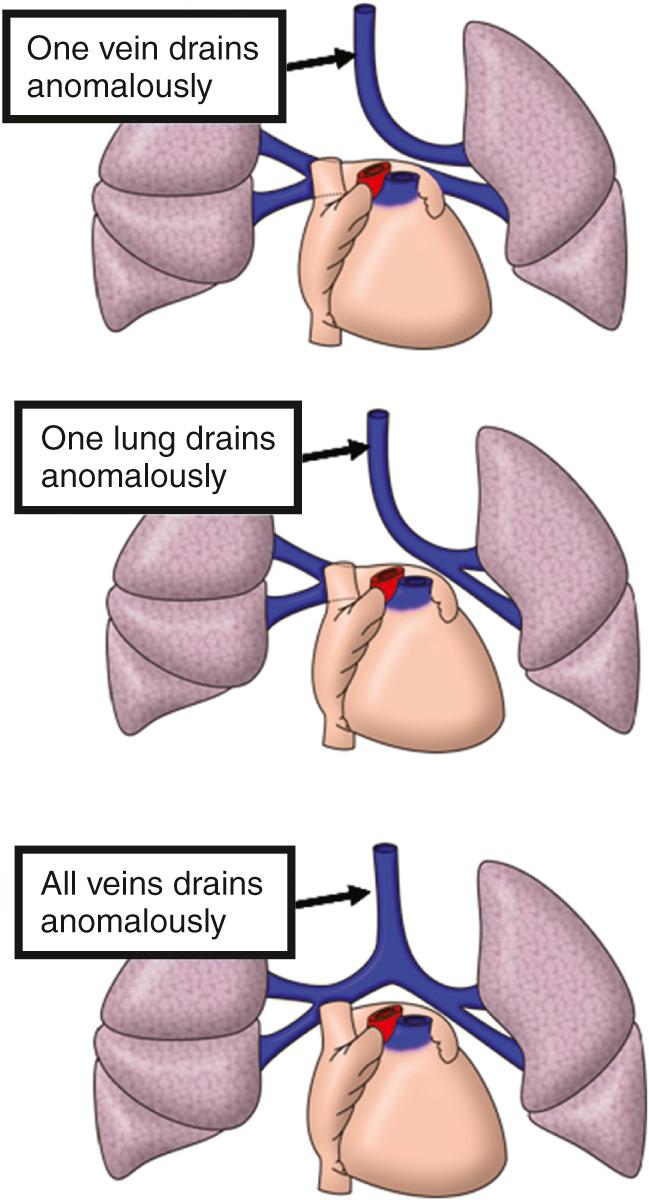
Before discussing these important anatomic variables in more detail, use of the term anomalous pulmonary venous connection should be explained. This is because, in certain circumstances, pulmonary veins connected in normal fashion to the morphologically left atrium can drain anomalously to a systemic site, such as when there is mitral atresia and an atrial septal defect or fenestration to the coronary sinus, or in the presence of the so-called levoatrial cardinal vein ( Fig. 28.3 ).
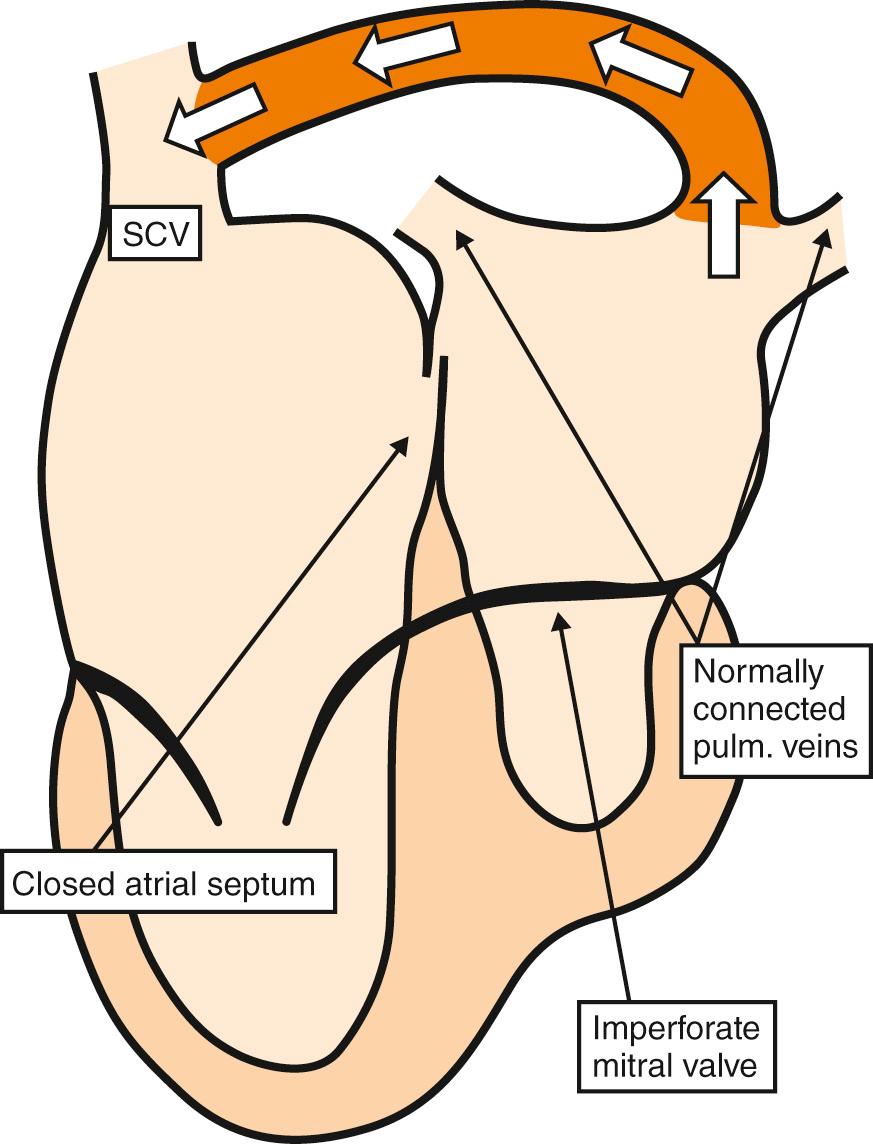
A pulmonary vein is connected anomalously only when it is attached to a site other than the morphologically left atrium. In this respect, it is also important to distinguish between the left-sided and the morphologically left atrium. In the presence of isomerism of the right atrial appendages, all four pulmonary veins are frequently connected to the roof of an atrium with a morphologically right appendage, which can be left sided. Because, in this setting, the atrium possesses a morphologically right appendage, this anatomic pattern is anomalous. Indeed, the pulmonary veins must be connected anomalously in the setting of right isomerism irrespective of their site of drainage. The topic of pulmonary venous connections in hearts with isomeric appendages, therefore, represents a special situation that is discussed in depth in Chapter 26 . In this chapter, we are concerned primarily with totally anomalous connection in the setting of lateralized atrial chambers―in other words, the usual and mirror-imaged arrangements―but reference is made where appropriate to hearts with isomeric appendages.
When all the pulmonary veins are connected anomalously, they usually drain to the same site. In some situations, different pulmonary veins are connected to separate anomalous sites. This is called mixed drainage ( ). The sites of such drainage are the same as when the entirety of the pulmonary venous return reaches an extracardiac site through a confluence. These sites of anomalous connection are divided into supracardiac, cardiac, and infracardiac groups. The first two, taken together, constitute supradiaphragmatic drainage, whereas infracardiac drainage is at the same time infradiaphragmatic ( Fig. 28.4 ).
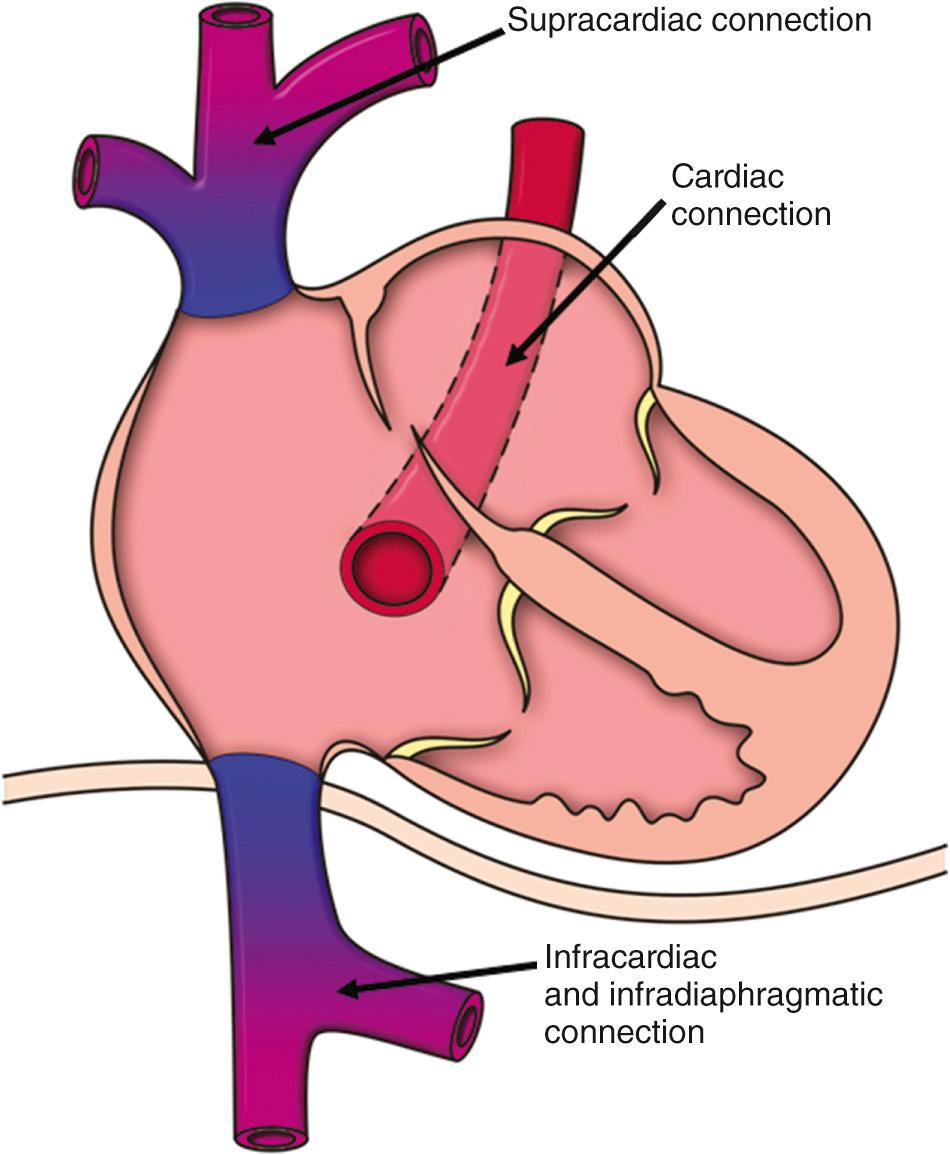
Cardiac and intracardiac anomalous connections account for approximately one-quarter each of the total group. Supracardiac connection can be to the left brachiocephalic vein, directly to the right superior caval vein, to the azygos system of veins, or to the left superior caval vein, although when the left vein drains to the coronary sinus, this is considered as cardiac drainage. In the most common pattern, the four pulmonary veins usually join in turn to a venous channel behind the left atrium. This channel is traditionally termed the confluence but the individual veins usually join the channel sequentially. From this horizontal channel, a vertical vein typically runs through the left paravertebral gutter to join the left brachiocephalic vein, which terminates in the right superior caval vein ( Fig. 28.5 ; ). It is the course of the vertical vein that usually determines whether or not the pathway is obstructed. If the vein passes anterior to the left pulmonary artery, this course is not associated with obstruction. Should the vein pass between the left pulmonary artery and the left bronchus, these two structures clasp the channel in the so-called bronchopulmonary vise ( Fig. 28.6 ). Obstruction with this “snowman” pattern of anomalous connection can also occur, although rarely, at the opening of the brachiocephalic vein into the superior caval vein. Supracardiac connection can also be found when the vertical vein joins directly with the right superior caval vein. Obstruction may occur either at this caval venous junction or in another vise, this time between the right pulmonary artery and the carina. When the anomalous pulmonary veins join the systemic venous system through the azygos vein, the horizontal vein usually crosses from left to right beneath the heart, again receiving the individual pulmonary veins in sequential fashion. The vertical vein ascends in the right paravertebral gutter, joining the superior caval vein through the azygos vein ( Fig. 28.7 ).

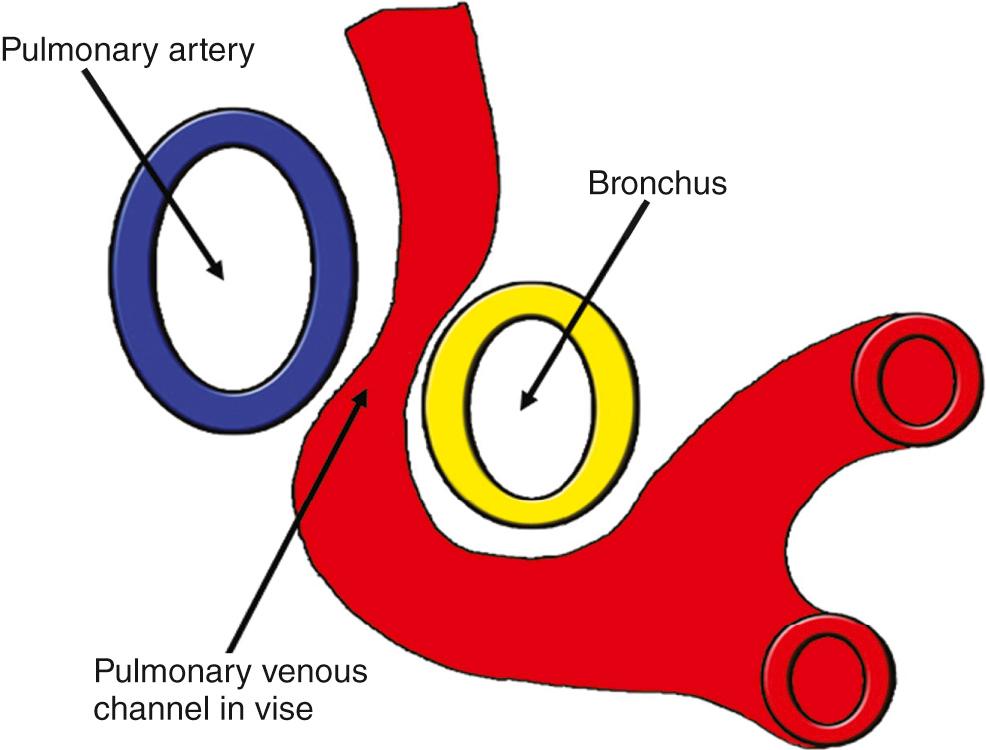
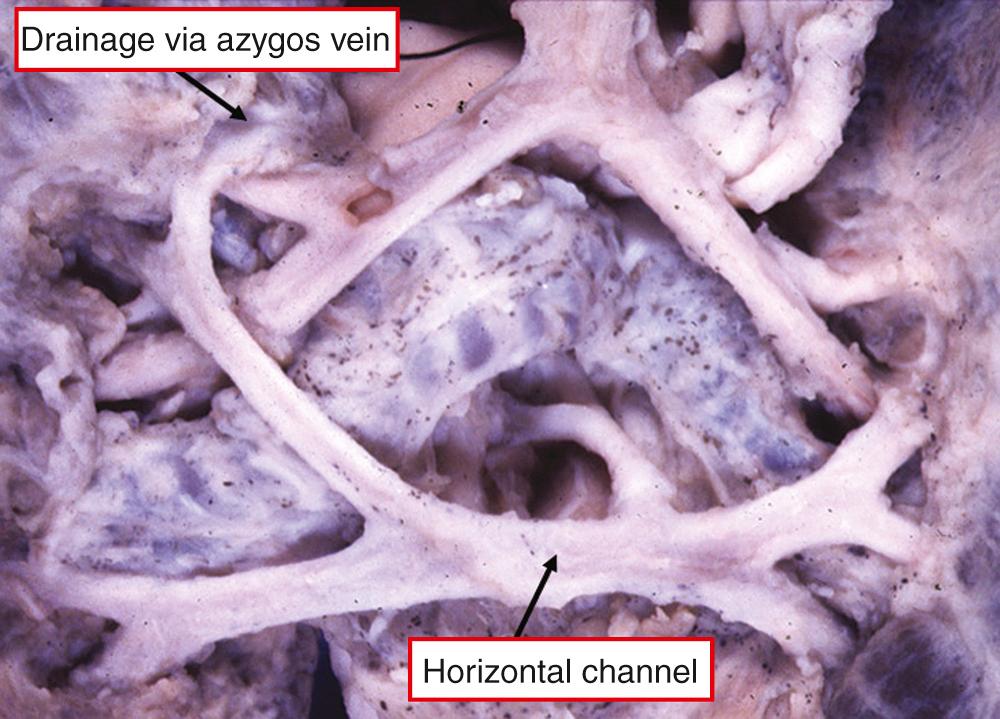
When there is a usual, or mirror-imaged, atrial arrangement, the cardiac form of anomalous connection is almost always found when the pulmonary veins join the right atrium via the coronary sinus ( Fig. 28.8 ). It can be questioned whether this should be considered a cardiac connection or one via the persistent left superior caval vein. Irrespective of such niceties, there is no question but that the site of return is within the heart, so cardiac connection is an apt description. The individual pulmonary veins can drain in various patterns to the coronary sinus, but the final common pathway is the sinus within the left atrioventricular groove, this typically being enlarged relative to the normal situation. Separate walls of coronary sinus and left atrium separate the horizontal venous channel from the left atrial cavity, although the walls can readily be removed surgically. Repair of the anomalous connection is achieved simply by closing both the mouth of the coronary sinus and the interatrial communication, taking care, of course, to respect the atrioventricular conduction tissues within the triangle of Koch. Obstruction is rare when the pulmonary veins drain through the coronary sinus, but it can be produced by persistence of the thebesian valve or within the sinus when the individual veins connect in unusual fashion.
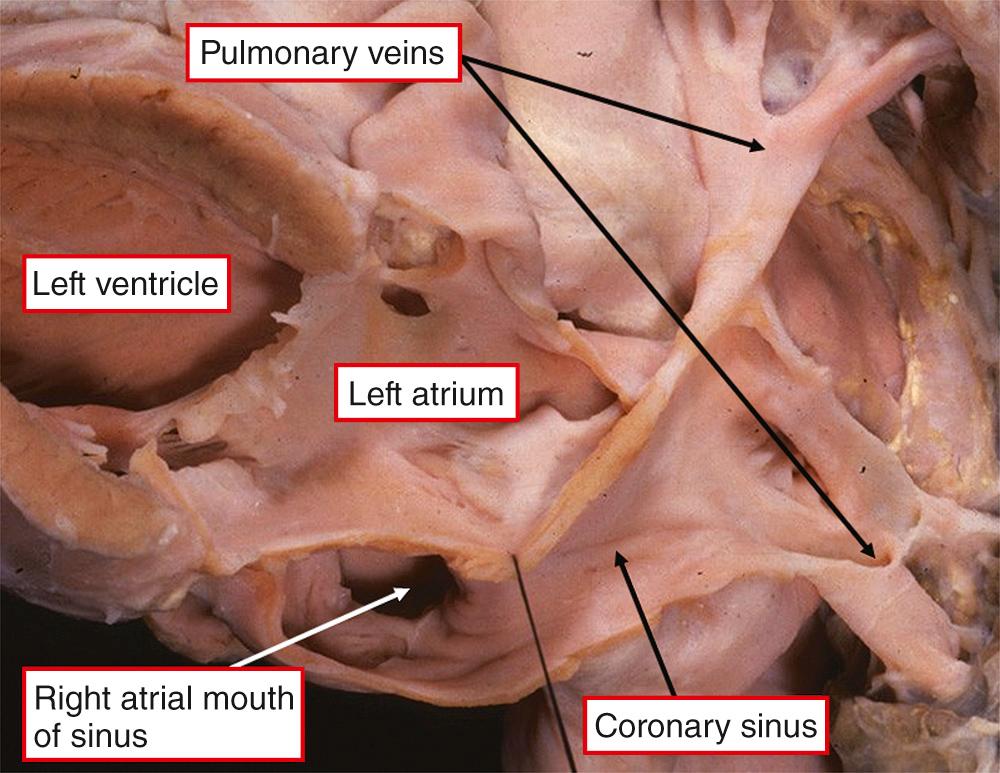
Direct connection of the pulmonary veins to the morphologically right atrium is exceedingly rare other than in the setting of isomerism of the right atrial appendages. In this setting, the coronary sinus is absent and most usually the atrial septum is deficient, frequently virtually absent. The pulmonary veins tend to crowd together, opening through a midline fibrous confluence in the atrial roof ( Fig. 28.9 ). Because the confluence lacks muscle, it can be obstructive. Less frequently in hearts with isomeric right appendages, the atrial septum can be much better formed, yet still the pulmonary veins connect directly to one of the atria ( Fig. 28.10 ). This arrangement must be anticipated in hearts with the usual or mirror-imaged atrial arrangement, but we have yet to identify such a case.

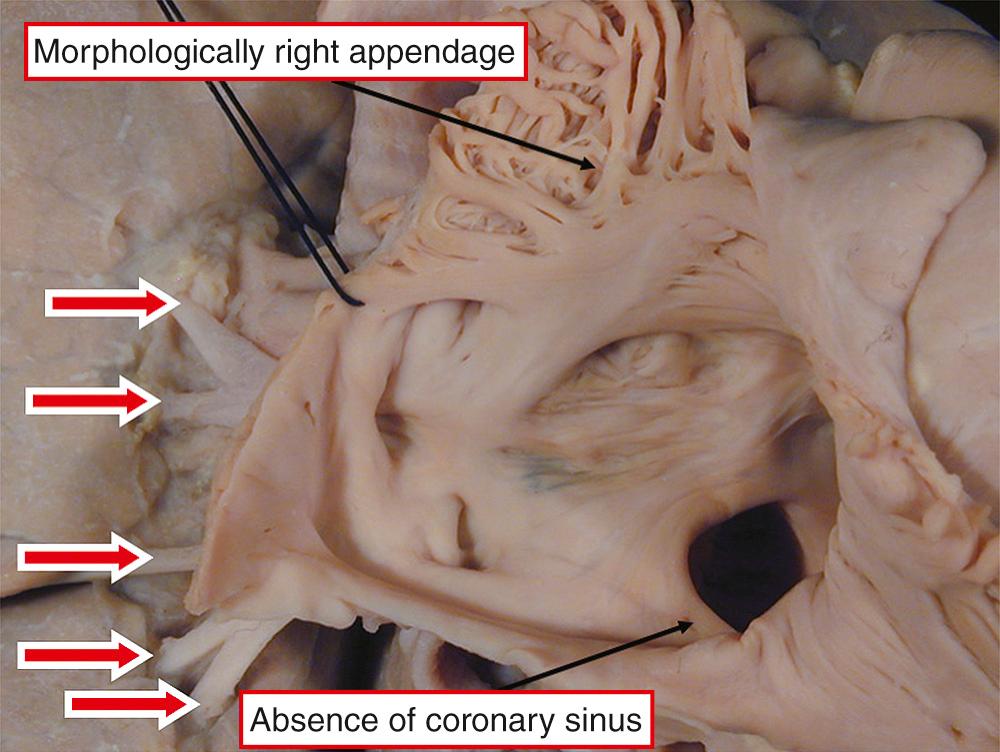
The final site of anomalous connection is both infracardiac and infradiaphragmatic. In this pattern, the pulmonary veins join together, entering a descending vertical vein that passes into the abdomen through the esophageal orifice of the diaphragm. It usually drains to the portal vein or to one of its tributaries ( Fig. 28.11 ; ). Drainage to the inferior caval vein is very rare. When the infracardiac connection is to the portal venous system, obstruction is almost always present subsequent to closure of the venous duct. Once this component of the fetal circulation has closed, the blood must pass through the hepatic tissues to reach the systemic veins. Additional discrete stenosis can be found as the vertical vein passes through the diaphragm, while the channel can also break up into a delta of smaller channels that terminate in the tributaries of the portal vein.
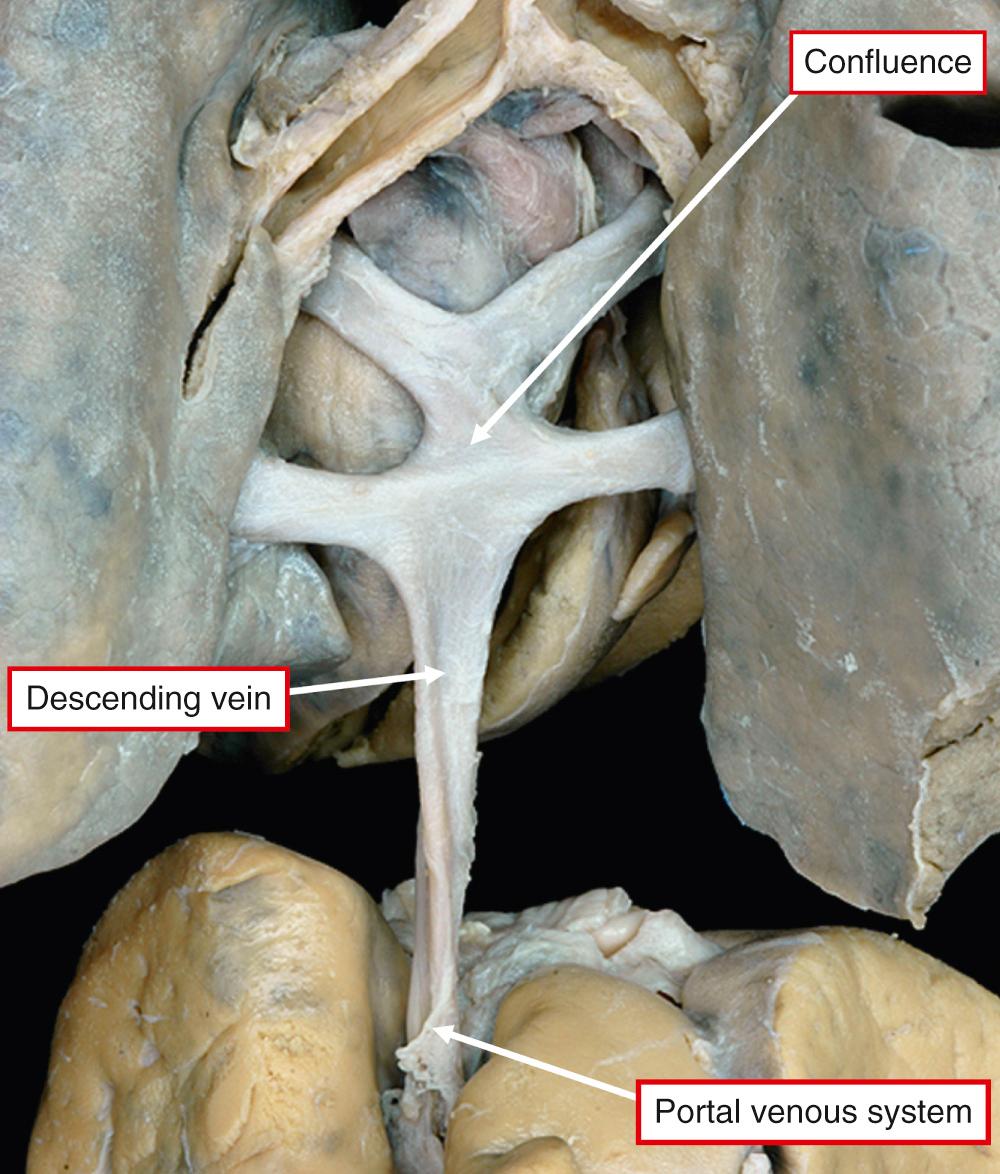
In all the situations illustrated, we have shown the anomalously connecting pulmonary veins draining to the same site within the systemic system. As discussed, it is also possible for different veins to terminate in different anomalous sites. This is called mixed anomalous connection . When it is seen, some of the veins can join together before draining to one of the multiple sites of anomalous connection, but different parts of the lung usually drain through discrete channels. In very rare situations, all of the pulmonary veins can join a common confluence, but the confluence itself drains via separate channels, for example to both a left vertical vein and the coronary sinus. With all these patterns of mixed anomalous connection, the same potentials exist for the pathways to become obstructed as when all the pulmonary veins drain anomalously to the same site, as discussed earlier.
Even excluding those cases of TAPVC associated with isomeric right atrial appendages, a large proportion of the patients have significant associated malformations. In these patients, such as those with abnormal ventriculoarterial connections or tetralogy of Fallot, the associated abnormality is probably the major lesion. Even when the anomalous connection is isolated, there is almost always an interatrial communication present, so that venous blood is able to reach the left side of the heart. The atrial septum can be intact. This requires an alternative route for blood to reach the left side of the heart (see later).
In any patient with TAPVC, the size of the left atrium and left ventricle are of obvious concern to the surgeon. At first sight, these structures seem small to the morphologist because of the disparate hyperplasia of the right atrium and right ventricle. Measurements, however, show that the left-sided structures are usually of adequate dimensions. It is rare for there to be any great distance between the pulmonary venous confluence and the left atrium (see Fig. 28.11 ). Taken together, these features serve to facilitate surgical repair in virtually all patients. Problems, when they exist, are likely to be found in patients with mixed drainage or in the setting of isomerism of the morphologically right atrial appendages.
Further problems can be created by changes in the pulmonary vasculature. Autopsy studies reveal changes in the veins of all patients studied, even including those dying on their first day of life, indicating that the changes themselves occur during fetal life. The veins take on arterial characteristics, and there is also an increase with age in the muscularity of the pulmonary arteries. All these features point to the need for immediate surgical repair once the anomaly is diagnosed.
Knowledge of the development of the pulmonary veins provides a good explanation for anomalous pulmonary venous connections. The developing atrium is itself initially connected to the mediastinum through the so-called dorsal mesocardium, even prior to formation of the lung buds from the trachea (see Chapter 3 ). As the lungs develop, the plexus of intrapulmonary veins joins with a pulmonary venous channel that canalizes in the developing mediastinum. The newly formed primary pulmonary vein uses the original connections of the dorsal mesocardium to gain access with the atrial component of the developing heart tube. After normal fusion with the developing intrapulmonary venous plexuses, the pulmonary veins themselves are “cannibalized” by the atrium to form the venous components of the normal morphologically left atrium. This occurs relatively late in development. TAPVC is the consequence of failure of canalization of the pulmonary venous channel in the mediastinum. Initially, since the lung buds themselves are derived from the foregut, the intrapulmonary veins also have connections to the systemic venous system. Should the pulmonary venous channel fail to develop, these anastomoses between pulmonary and systemic venous systems persist and enlarge. An anastomosis with the anterior cardinal systemic venous system results in supracardiac anomalous connection. Anastomosis with the systemic venous sinus, or the left sinus horn, produces cardiac connection, whereas infradiaphragmatic connection is the consequence of anastomosis with the omphalomesenteric system. In the strictest sense, these anastomoses are neither anomalous nor pulmonary. If they persist, they certainly result in an anomalous pulmonary venous connection. Rarely, hearts may be found in which the pulmonary venous channel has formed but has become atretic in its course between the atrium and the intrapulmonary venous plexuses. Indeed, sometimes the pulmonary veins may be adjacent to the left atrium, but with musculature present between the two developmental components. An anomalous channel, analogous to the levoatrial cardinal vein, provides the only route for drainage of pulmonary venous blood. All of these examples are readily explained using the developmental hypothesis discussed earlier. It should be noted that although the development of normal pulmonary venous anatomy is well studied, current thoughts about the development of anomalous pulmonary venous connections is conjectural, based on a combination of morphologic observations and findings from normal development. This discussion should, therefore, be viewed in light of that caveat.
There is an obligatory left-to-right shunt, since pulmonary venous return is to the systemic veins or right atrium. A systemic output can be maintained only if there is a right-to-left shunt, which is almost always at the atrial level. As already discussed, exceptional cases have been described in which the atrial septum was intact. In these patients, the right-to-left shunt occurred either at the ventricular or ductal level.
When the right-to-left shunt is at the atrial level, there is a tendency for fetal patterns of flow to be maintained by the valvar mechanism of the oval foramen. Thus, in most patients with an infradiaphragmatic connection, the oxygenated blood ascending the inferior caval vein toward the right atrium is directed toward the left atrium. Systemic arterial oxygen saturation is accordingly higher than that in the pulmonary arteries. When the anomalous venous connection is supracardiac, oxygenated blood tends to be directed down the superior caval vein and through the tricuspid valve. Consequently, in some of these patients, pulmonary arterial blood is more oxygenated than systemic arterial blood. In the presence of a patent arterial duct, this flow pattern can result in reverse differential cyanosis, with higher oxygen saturation in the upper extremities than the lower extremeties. In the others, mixing is complete. Similar patterns are found for anomalous connection to the coronary sinus. This is presumably because the orifice of the coronary sinus is directed more toward the tricuspid valve than the oval fossa.
Obstruction to pulmonary venous return can occur at any of the anatomic sites documented earlier. Infants with evidence of borderline venous obstruction should be reevaluated, since the combination of decreasing pulmonary vascular resistance and increased blood flow to the lungs typically seen in the postnatal period may unmask more severe obstruction. When there is definable obstruction, the right ventricular pressure is usually suprasystemic. There are many infants, particularly those with return to the coronary sinus, in whom the systolic pressure in the two ventricles is more or less equal despite absence of any definable obstruction. Indeed, in one study, no significant difference was found in systolic pressures measured in either the right ventricle or the pulmonary arteries between patients with and without obstruction and with supracardiac or intracardiac connections. This suggests that the main cause of pulmonary hypertension in patients without apparent pulmonary venous obstruction is elevation of pulmonary resistance, presumably as a result of extension of muscle into peripheral arterioles and veins. If this is the cause, the almost invariable fall to normal after successful repair indicates that the process is reversible. Alternatively, at least part of the problem may result from undetected anatomic causes of pulmonary venous obstruction.
The contribution of the oval foramen to the problem is controversial. In theory, obstruction of this foramen leads to a high right atrial pressure, which impedes pulmonary venous return and thus produces pulmonary hypertension. Gathman and Nadas argued on three grounds, however, that significant obstruction of pulmonary venous return at the atrial level was rare. First, patients as a group had similar right atrial pressures, whether they were pulmonary hypertensive or not. Second, about a third of patients with pulmonary hypertension had no pressure gradient at the atrial level. Indeed, in a few, mean left atrial pressure was higher than right. Third, almost all patients with pulmonary vascular obstruction also had pulmonary venous obstruction. Although these arguments are persuasive as to the insignificant role of the oval foramen in producing pulmonary hypertension, they do not rule out the possibility that a small foramen could limit systemic flow.
When pulmonary venous return is unobstructed, right ventricular diastolic pressure is low and right ventricular compliance relatively high. Blood returning to the right atrium, therefore, tends to enter the right ventricle rather than the left atrium. Flow of blood to the lungs tends greatly to exceed flow in the systemic circuit. Right ventricular end-diastolic and stroke volumes are considerably increased in consequence. Since mixing of pulmonary and systemic venous blood is complete apart from the minor degrees of streaming discussed previously, right atrial and therefore systemic arterial blood is well oxygenated, with saturations of oxygen found in excess of 90%.
In the presence of pulmonary venous obstruction, in contrast, pulmonary venous pressure is raised. If the pressure is sufficiently severe, pulmonary edema is produced, although bronchopulmonary venous anastomoses may relieve pressure to some degree. In severe cases, pulmonary arterial pressure is raised even above systemic pressure, and pulmonary blood flow is reduced. The right ventricle, therefore, becomes pressure- rather than volume-overloaded. Systemic arterial oxygen saturation may fall to values of 20% to 30%. The depression of systemic arterial saturation, and possibly also output, results in tissue hypoxemia and metabolic acidosis. These effects of pulmonary venous obstruction are compounded by the changes in small pulmonary veins and arteries already described, which may further increase pulmonary vascular resistance.
In the occasional patient who survives infancy without severe pulmonary venous obstruction, late pulmonary vascular obstructive disease may develop, as in those with atrial septal defect. The effects are the same as those of pulmonary venous obstruction except that no pulmonary edema occurs.
Very occasionally, TAPVC can present as sudden death in the first 2 months of life. As long ago as 1962, Hastreiter and colleagues recognized that the main determinant of the clinical picture was the presence of pulmonary venous obstruction. Consequently, for each of the ensuing sections relating to the clinical picture, patients will be divided into those with and without pulmonary venous obstruction. Some patients with only modest obstruction fall between the two groups and exhibit features of both.
Patients with severe pulmonary venous obstruction present in the first week or two of life with obvious cyanosis and difficulties with feeding and respiration. In contrast to what is observed in the respiratory distress syndrome, grunting respiration is very rarely seen in obstructed venous return. Pointers to respiratory distress syndrome rather than totally anomalous pulmonary connection are maternal diabetes, prematurity, cesarean section, and a very early onset of respiratory difficulties. Any or all of these can be found in the setting of anomalous pulmonary venous connection. In a study of the registry of the Extracorporeal Life Support Society in 1992, containing 4823 patients, 623 patients were thought to have persistent fetal circulation. Of these, 10% were shown to have congenital heart disease. About half had TAPVC, while 10% had complete transposition. This emphasizes how easy it is, if echocardiography is not performed, to mistake TAPVC for persistent fetal circulation. A unique mode of presentation, hematemesis, was described in one patient with infradiaphragmatic return to the left gastric vein. Another unique mode was severe unconjugated hyperbilirubinemia in the setting of infradiaphragmatic return. The patient survived exchange transfusion and surgical repair.
Patients without severe pulmonary venous obstruction tend to present in heart failure at 2 to 3 months of age. They have a history of difficulties with feeding and sometimes chest infections. Cyanosis is generally not a symptom.
Those with severe pulmonary venous obstruction are sick neonates with obvious or severe cyanosis. Skin mottling is frequent, reflecting poor peripheral perfusion and metabolic acidosis. Tachypnea is usually marked, although respiration is quiet. Hepatomegaly is occasionally considerable, particularly when drainage is to the portal vein. The peripheral pulses are often somewhat weak. The precordium is quiet. On auscultation there are usually no murmurs. If a murmur does exist, it is usually unimpressive and midsystolic. Occasionally a venous hum is heard in the region where pulmonary venous return is obstructed, for example under the left clavicle in anomalous connection via a left vertical vein. The first heart sound is single and the second heart sound is described as exhibiting “physiologic” or “fixed” splitting. The pulmonary component is accentuated and a fourth heart sound may be heard. Rarely, the second heart sound appears single.
When seen from the end of the bed, patients without severe pulmonary venous obstruction resemble patients with large ventricular septal defect. They are scrawny and tachypneic, with retractions. The presence of cyanosis can certainly be missed if the infant is examined in a poor light. Even in a good light, it may not be detected. There is usually hepatomegaly, and rales may well be heard in the lungs.
The peripheral pulses are normal to small and the precordium is overactive but without any thrill. On auscultation, the first heart sound is normal and there is usually wide fixed splitting of the second sound. An ejection systolic murmur is heard in the pulmonary area owing to excessive flow through the pulmonary valve. A mid-diastolic murmur tends to be heard at the lower left sternal border, representing excessive flow through the tricuspid valve.
Patients without pulmonary venous obstruction very occasionally survive infancy without heart disease being detected. These patients present as does a typical patient with atrial septal defect but with the added features of mild cyanosis and clubbing.
Newborns with severe pulmonary venous obstruction have a characteristic chest radiograph with a small or normally sized heart framed by ground-glass lung fields ( Fig. 28.12 ). Kerley B lines are occasionally seen. These appearances are sometimes confused with those of respiratory distress syndrome. However, unlike respiratory distress syndrome, pulmonary venous obstruction generally results in a uniform distribution of changes in the lung fields. Furthermore, obliteration of part or the entire cardiac silhouette and the appearance of an air bronchogram are both highly characteristic of respiratory distress syndrome and are rare in those patients with TAPVC.
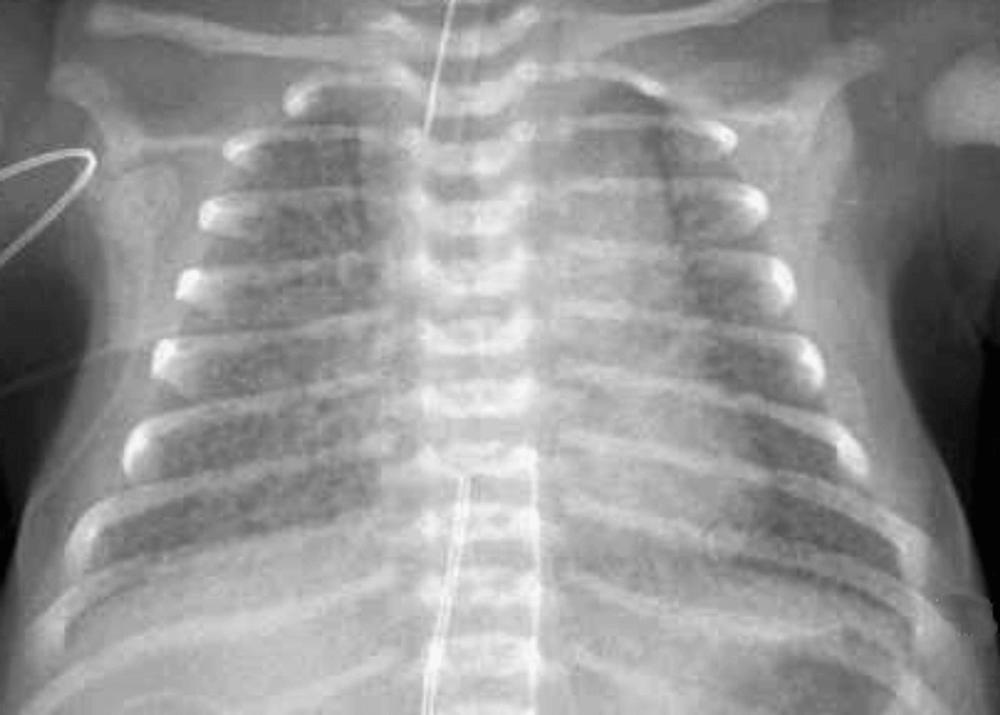
Patients without severe pulmonary venous obstruction have enlarged hearts because of the right ventricular volume overload together with engorged lung fields. The pulmonary trunk becomes prominent in older patients, as does the left vertical vein when this is the site of the anomalous venous connection. This gives rise to the “snowman” appearance, known to almost every pediatrician and also described as the “W.C. Fields heart.” This is now of mainly historic importance because patients usually have their defect corrected long before the snowman has time to appear, which was previously in the second year of life. Less than one-third of infants with supracardiac anomalous connection exhibit the snowman. Rarely, however, the snowman has been reported as early as 3 months of age.
The electrocardiogram shows right axis deviation with a clockwise frontal plane loop and right ventricular hypertrophy. V1 usually shows an rsR’ pattern, although a qR is seen in 80% of patients. The latter might be thought to indicate the presence of more severe pulmonary hypertension, but there is poor correlation between the two. Disturbances of conduction are rare. Under 1 month of age, only about 1 in 12 patients have right atrial hypertrophy, whereas this is seen in 75% between 1 and 3 months and in 90% over 3 months. Patients with pulmonary venous obstruction who present younger are much less likely to have right atrial hypertrophy than those without pulmonary venous obstruction.
Echocardiography is the definitive noninvasive method of diagnosis. Even as long ago as 1979, it was shown that it was possible to image at least one vein connected to the left atrium in 94% of infants under 3 months of age with normally connected pulmonary veins and at least two in 77%. Correlative anatomic studies suggest that the subcostal and apical approaches image the normal left lower and right upper pulmonary veins, whereas the suprasternal approach, given a good window, can demonstrate all four. With modern techniques, therefore, it should be possible to demonstrate positively the normal pulmonary venous connections in all neonates and infants. Any infant in whom normal pulmonary venous connections cannot be clearly seen should be sent for further imaging, whether it is additional echocardiography or other modalities (see later).
When an echocardiogram is being performed, there are certain clues that should direct one toward the diagnosis of TAPVC. Exclusive right-to-left shunting at the atrial level (through an atrial septal defect or patent foramen ovale) is abnormal in any setting and should not be presumed to be a result of right ventricular hypertension ( Fig. 28.13 ). It should be assumed that any patient with this finding has a TAPVC until proven otherwise. Other clues include a small left atrium, a dilated superior caval vein ( Fig. 28.14 ), nonpulsatile caudally directed flow seen below the level of the heart in subcostal imaging, or nonpulsatile cranially directed flow seen above the level of the heart. Each of these findings should lead one to entertain the possibility of TAPVC.
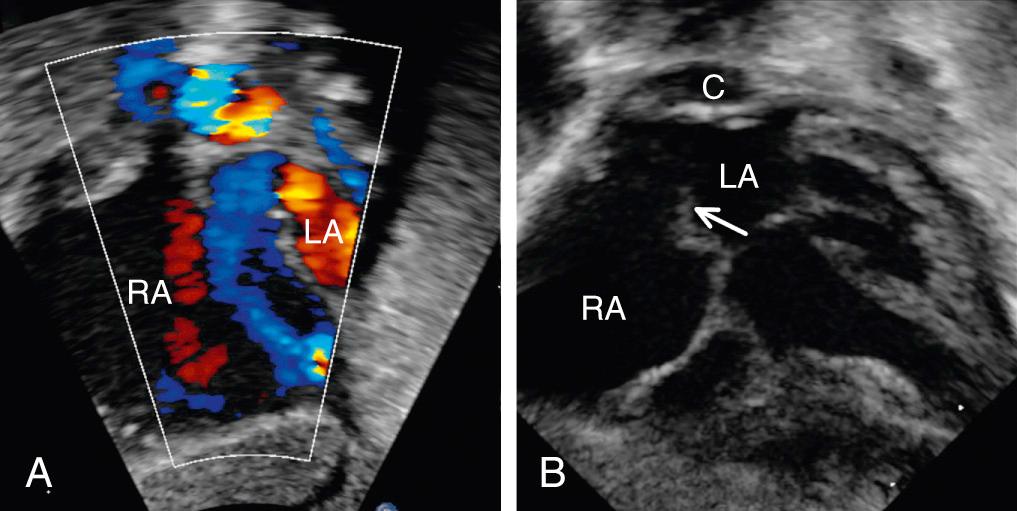

Failure to demonstrate any pulmonary vein connected to the left atrium should lead to an assiduous search for the key positive feature required for diagnosis. This is the pulmonary venous confluence, or collecting venous channel, which was recognized in 21 of 23 patients studied by Smallhorn and colleagues. As has been emphasized, when the pulmonary veins are connected anomalously to the coronary sinus, the collecting venous channel is often the coronary sinus itself. From multiple views, the confluence can be seen as an echo-free nonpulsatile region posterior to and clearly separate from the left atrium (see Fig. 28.13 ). Care should be taken to distinguish this confluence from a pulmonary artery. The pulmonary arteries originate from the pulmonary trunk are more anterior and are usually pulsatile. The subcostal and parasternal short-axis views also demonstrate the size of the interatrial communication. A characteristic picture of the pulmonary veins entering the confluence is obtained in the suprasternal or parasternal short-axis views. The vertical vein can be readily identified from the suprasternal approach ( Fig. 28.15 ). The confluence can also be a longer channel, collecting the individual veins sequentially, and even more rarely, may be somewhat removed from the left atrium. Once the confluence has been discovered, its connection to the systemic venous circulation must be determined.
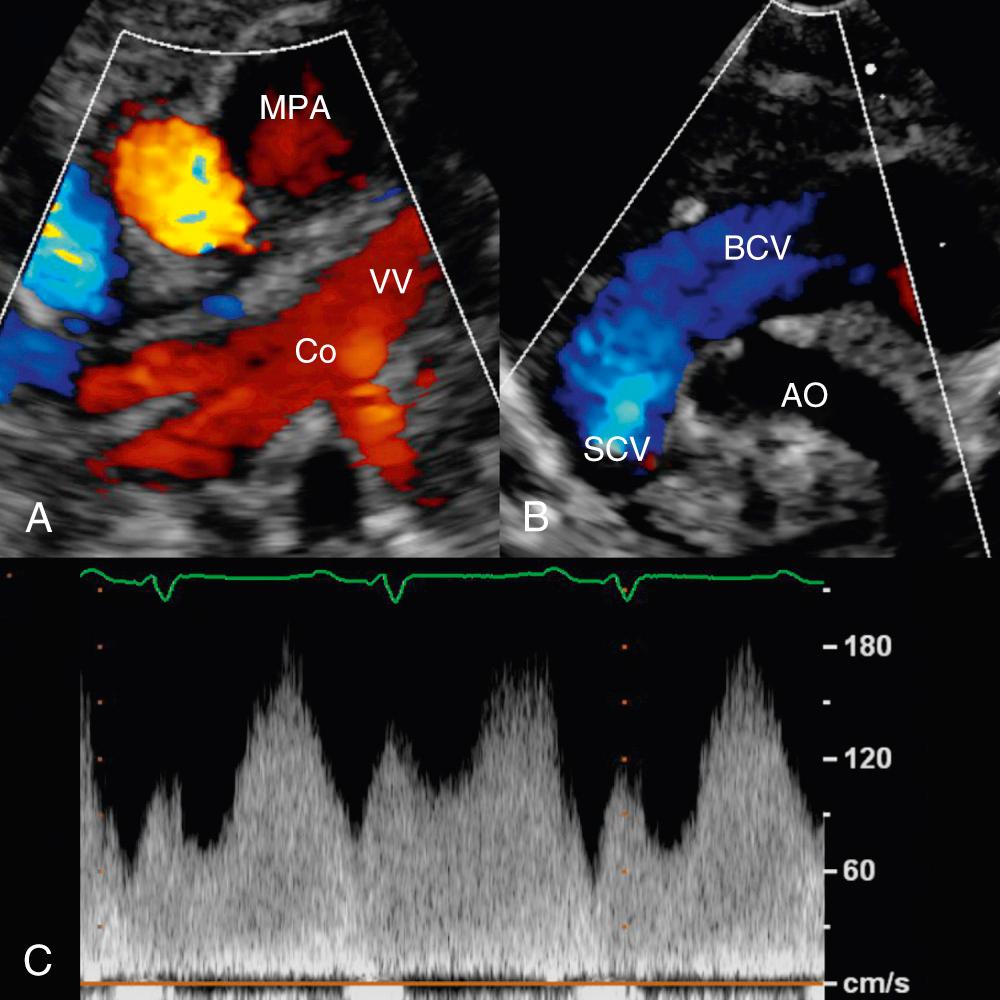
A descending vein, as found in anomalous infradiaphragmatic connection, can sometimes be seen descending from the confluence from the suprasternal approach. Much more commonly, the descending vein is found by placing the transducer so as to obtain a subcostal short axis cut of the aorta or inferior caval vein and then scanning from left to right. The descending vein is recognized as it penetrates the diaphragm ( Fig. 28.16 ). Spectral and color Doppler should be used to evaluate the direction and pulsatility of any vessel seen crossing the diaphragm. It is distinguished from the aorta both by its lack of pulsation and its lack of connection to the superior mesenteric artery. It is differentiated from the inferior caval and hepatic veins by the direction of flow, its failure to enter one or other atrium, and by the fact that it originates behind the heart. If the site of termination is the portal vein, the descending vein often appears as a finger pointing anteriorly from the esophageal hiatus toward the hepatic portal. In our experience these discriminating features are sufficient to be diagnostic.
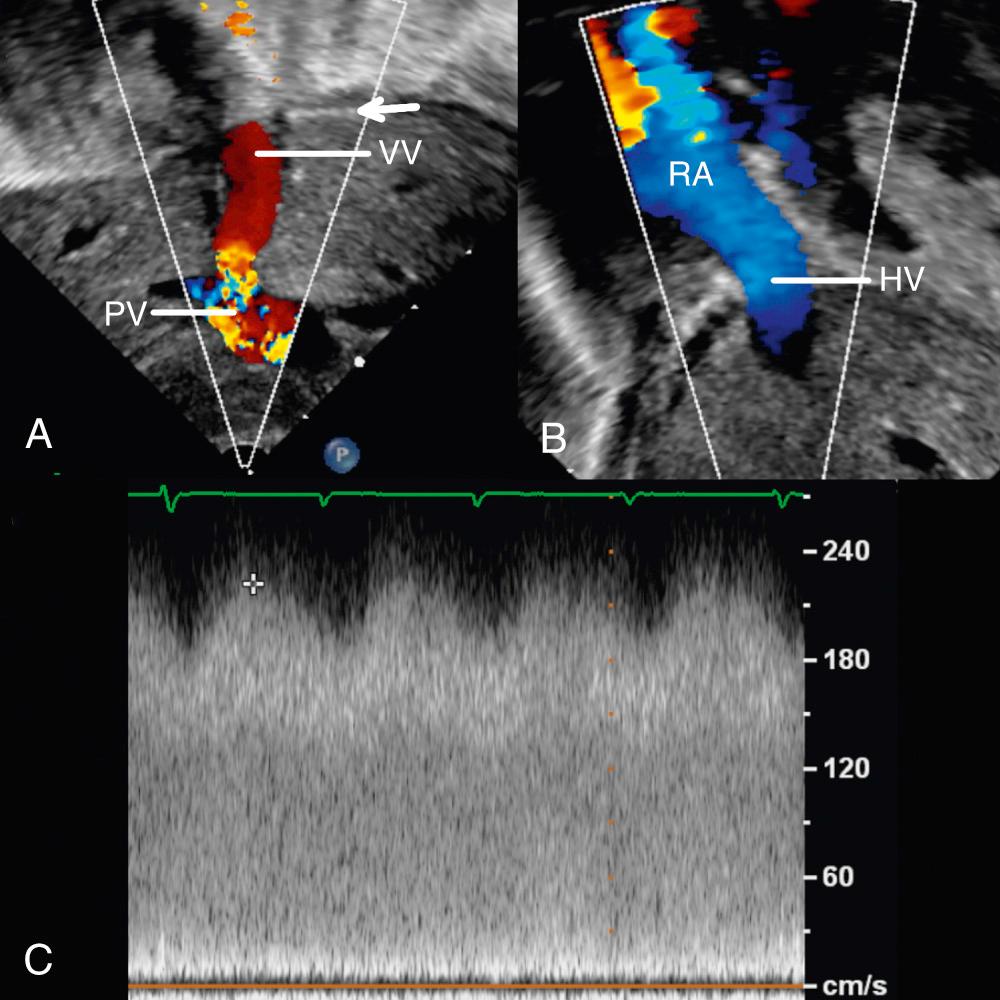
A superiorly directed vertical vein is best seen from the suprasternal approach, in which its connection with the brachiocephalic vein is easily visualized. The vertical vein can usually be traced from the confluence, particularly since its initial upward course and the confluence can often be seen in subcostal and apical cuts. Pulsed-wave and color Doppler should be used to evaluate the direction and pulsatility of any vessel seen connecting to the brachiocephalic vein from below. Similar rules apply when the vertical vein ascends in the right paravertebral gutter and terminates in the azygos vein.
If neither an ascending nor descending vein is identified, the anomalous connection is most likely either to the coronary sinus, superior caval vein, or directly to the right atrium. If it is to the coronary sinus, that structure, best identified in cross sections in a parasternal long-axis cut or the apical four-chamber cut as it lies within the left atrioventricular groove, will be enlarged and will bulge anterosuperiorly into the left atrium. Great care must be taken to distinguish between enlargement of the coronary sinus owing to persistence of the left superior caval vein and the pattern in which the pulmonary veins drain into it. Color Doppler can be used to identify pulmonary veins draining into the sinus ( Fig. 28.17 ). The inferior margin of the coronary sinus thus imaged corresponds to the atrioventricular junction. If the superior margin lies more or less parallel to it, this suggests connection to a left superior caval vein. If, however, the superior margin bulges superiorly, anomalous pulmonary venous connection should be suspected. This distinction can be confirmed by making small tilting and rotational movements of the transducer, which will show the anomalously connecting pulmonary veins. Anomalous connection to the right atrium or superior caval vein can be diagnosed if there is no ascending or descending vein, the coronary sinus is of normal size, and the pulmonary veins can be followed to their site of entry to the right atrium or superior caval vein ( Fig. 28.18 ). The echocardiographer should consider measuring the diameter of all four pulmonary veins between hilum and confluence, as the sum of these diameters is a strong and independent predictor of surgical survival. Most of the late deaths in this study were the result of individual pulmonary venous stenosis (PVS) at sites remote from the surgical anastomosis to the left atrium. In older patients, it can be difficult to image pulmonary veins from the precordium. Under these circumstances, transesophageal echocardiography, computed tomographic angiography (CTA), or magnetic resonance imaging (MRI) can be most helpful.
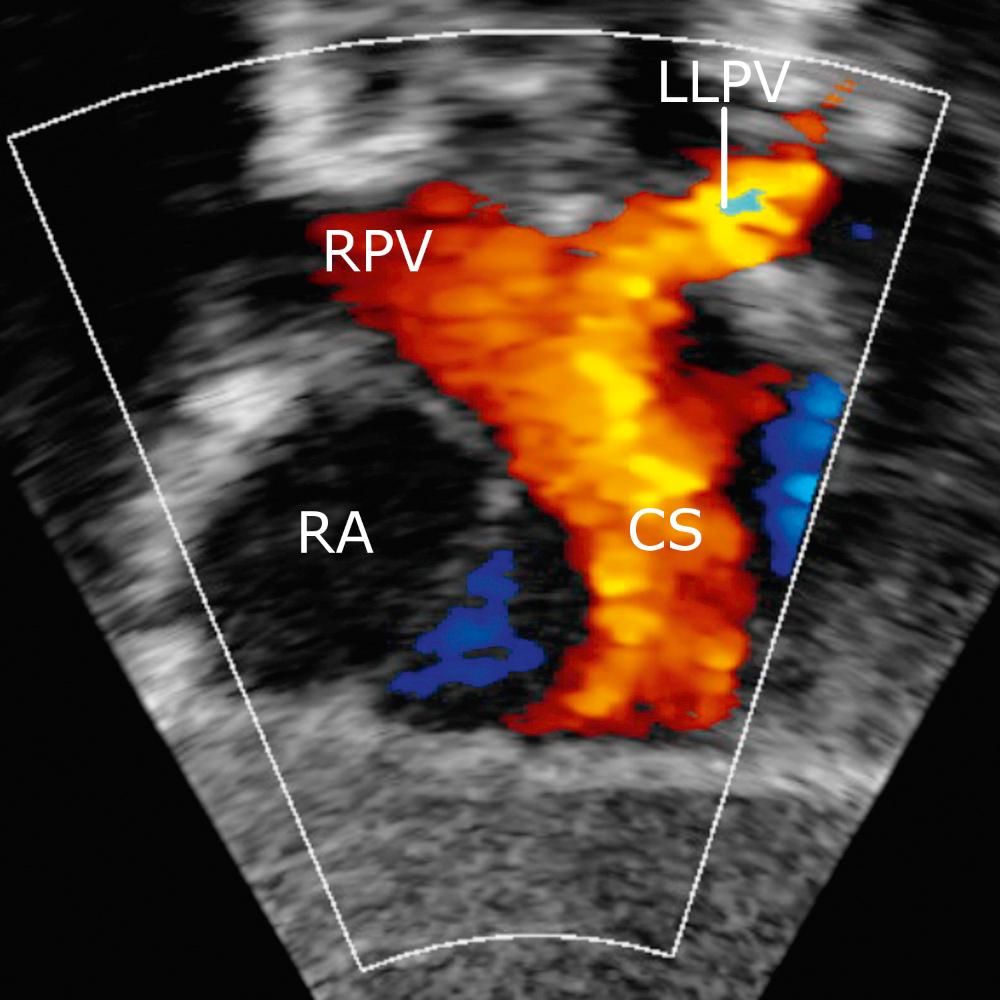
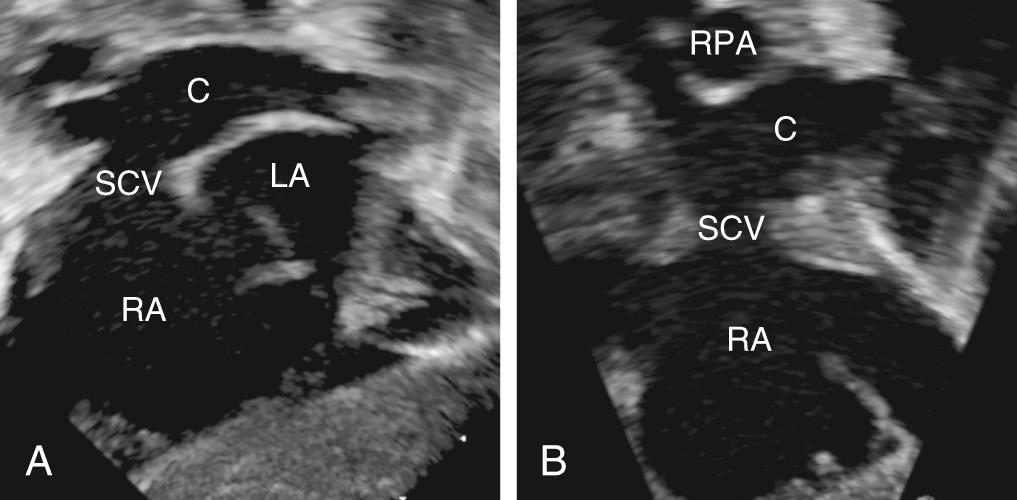
Color Doppler is essential to diagnosis in these patients. First, it becomes impossible to confuse a left vertical vein draining to the brachiocephalic vein with a persistent left superior caval vein except in the highly improbable association with atresia of the coronary sinus. The differences demonstrated in direction of flow apply equally to distinction between the inferior caval vein and the descending pulmonary venous pathway. Second, where there is doubt as to whether an image obtained is a genuine pulmonary vein or an artifact, the demonstration of color within the structure indicates that it is vascular. Third, sites of obstruction along the pulmonary venous pathway can be demonstrated as points of turbulence (see Fig. 28.16 ) or even absent flow both preoperatively and postoperatively. As is essential with color Doppler imaging of any venous structure, care must be taken to ensure an appropriate Nyquist limit for optimal detection of pulmonary venous drainage and obstruction.
In areas where color Doppler suggests obstruction, pulsed-wave Doppler offers an objective measure. The presence of a focal increase in flow velocity with a continuous, nonphasic flow pattern distally is a characteristic finding (see Fig. 28.16 ). A sensitivity of 100% and specificity of 85% have been claimed for detection of obstruction by cross-sectional imaging and color Doppler.
It is now the standard of care to diagnose and repair TAPVC based on echocardiography alone. In 1983, Stark and colleagues first reported successful repair of TAPVC in six young infants without previous cardiac catheterization. Subsequent experience confirms that skilled use of cross-sectional echocardiography avoids the need for additional imaging in the majority of patients. Mixed totally anomalous pulmonary venous return cannot always be fully delineated by echocardiography, however. If the clinical and cross-sectional echocardiographic findings do not fit the clinical scenario, additional imaging should be performed without hesitation.
Ultrasound technology has progressed to a degree that it is possible to diagnose TAPVC by fetal echocardiography, although it is often missed on screening ultrasounds in the absence of additional cardiac anomalies. The presence of a confluence behind the left atrium, a vertical vein, dilated coronary sinus or superior vena cava, or a widened gap between the descending aorta and the posterior wall of the left atrium are the most consistent echocardiographic clues. As with postnatal echocardiography, color and pulsed-wave Doppler analysis can assist greatly in identifying venous obstruction.
Cardiac catheterization and traditional angiography are rarely indicated in this era. If performed, they will document the pathophysiology already indicated. The pulmonary venous anatomy can almost always be delineated without invasive testing.
Technologic advances in medical imaging have increased the utilization of CTA and MRI in the evaluation of patients with anomalous pulmonary venous connection. Given the inherent complexity involved in understanding the three-dimensional relationships in these patients, multiplanar imaging techniques such as MRI and CTA allows three-dimensional representations of complex anatomic relationships. Pulmonary venous connections with a particularly tortuous course, as is often seen with infracardiac connection or drainage via the azygos system, can be difficult to follow by echocardiography. These multiplanar modalities allow one to follow even the most tortuous vessels in a relatively simple fashion. As early as 1991, Masui et al. found MRI to be superior to both echocardiography and conventional angiography in patients with TAPVC. Since then numerous other authors have endorsed its utility in these patients. In addition to imaging of complex structures, MRI allows for functional data including flow quantification and volumetric analysis. However, cardiac MRI requires a combination of technical expertise and knowledge of cardiac anatomy that is not readily available in all centers, and time-consuming scanning protocols along with the need for transition to “MRI safe” equipment limit the practicality of this imaging modality in the most critically ill infants.
High-resolution CTA using multidetector scanners has proven to be a highly accurate alternative in the diagnosis and characterization of anomalous pulmonary venous connections ( Fig. 28.19 ). Newer scanners have cut the scanning time to a few seconds or less, allowing most scans to be performed without sedation. Commercial software is readily available for three-dimensional reconstruction of these datasets (along with datasets from magnetic resonance angiography [MRA]), permitting those with reasonable knowledge in congenital heart disease to manipulate the anatomy in such a way that is easily understandable. In contrast to MRA, CTA allows for simultaneous three-dimensional reconstructions of additional thoracic structures. This feature makes it particularly useful in patients with a bronchopulmonary vise, in which the vertical vein is compressed between the bronchus and a pulmonary artery. In critically ill patents, CTA can be performed in an expeditious manner with minimal time away from the intensive care unit and without a need to transition to specialized equipment. This can be useful for patients who are on extracorporeal membrane oxygenation (ECMO).
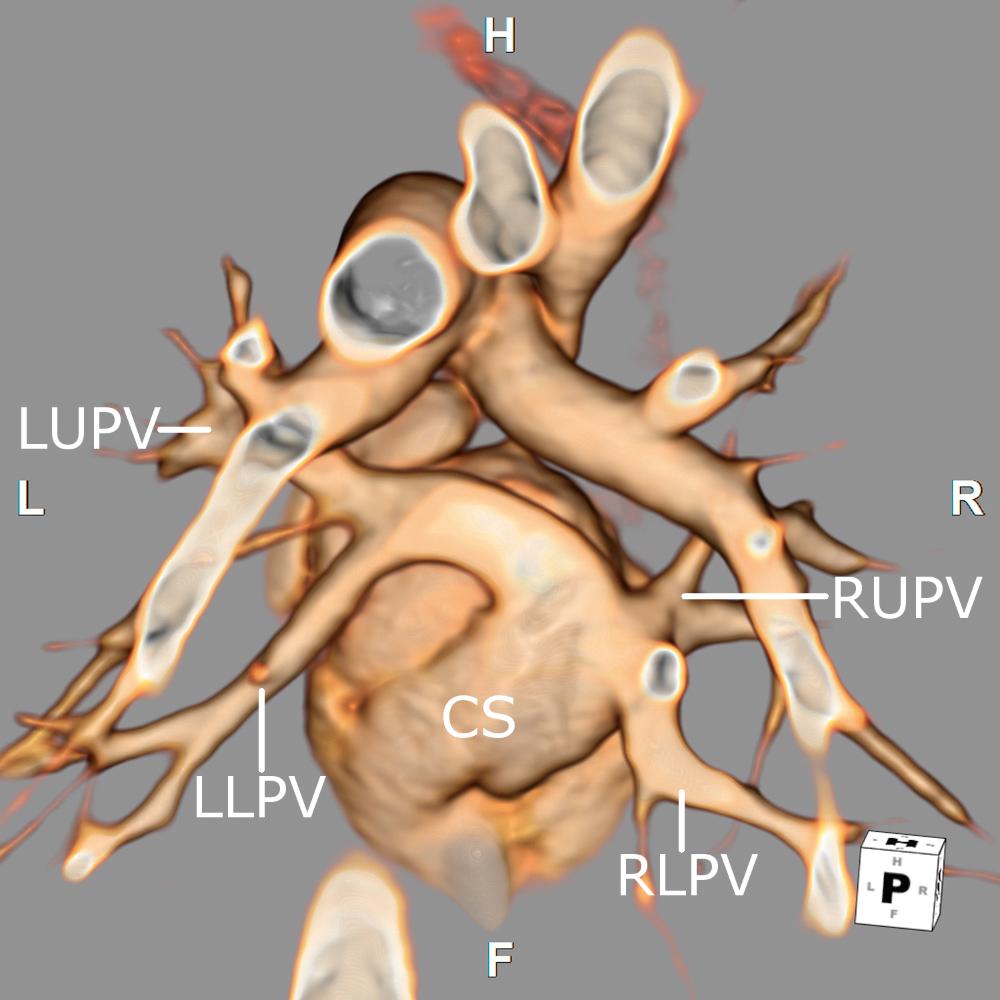
Unlike what is seen with traditional angiography, MRA and CTA will display contrast in multiple structures simultaneously. This is particularly useful in documenting mixed connections and clarifying spatial relationships in those with more complex anatomic arrangements ( Fig. 28.20 ). Instead of using multiple injections and catheter courses to search for each pulmonary venous connection, all connections can be located on one contrast injection. On the other hand, traditional angiography is likely superior in identifying pulmonary venous drainage from areas of the lung where there is no pulmonary blood flow, as these newer modalities have no acceptable substitute for a pulmonary artery wedge angiogram. When patients with suspected supracardiac drainage are being imaged, it may be useful to inject contrast from below the heart. Assuming that the scan is performed with the first pass of contrast through the heart, as is standard procedure, any contrast in a venous structure above the heart can clearly be identified as pulmonary venous in origin ( Fig. 28.21 ). This is particularly useful when one is trying to differentiate a left superior caval vein from a vertical vein. The converse can be applied to infracardiac connection ( Fig. 28.22 ).
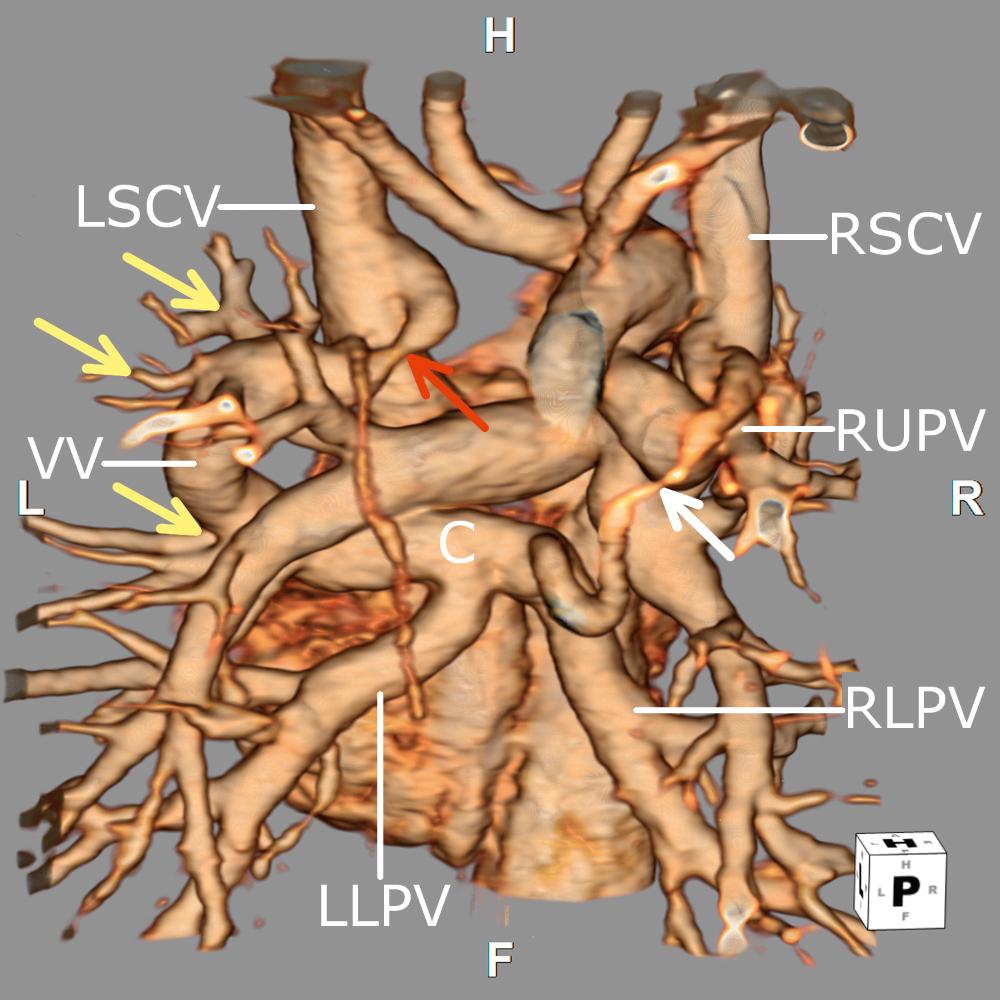
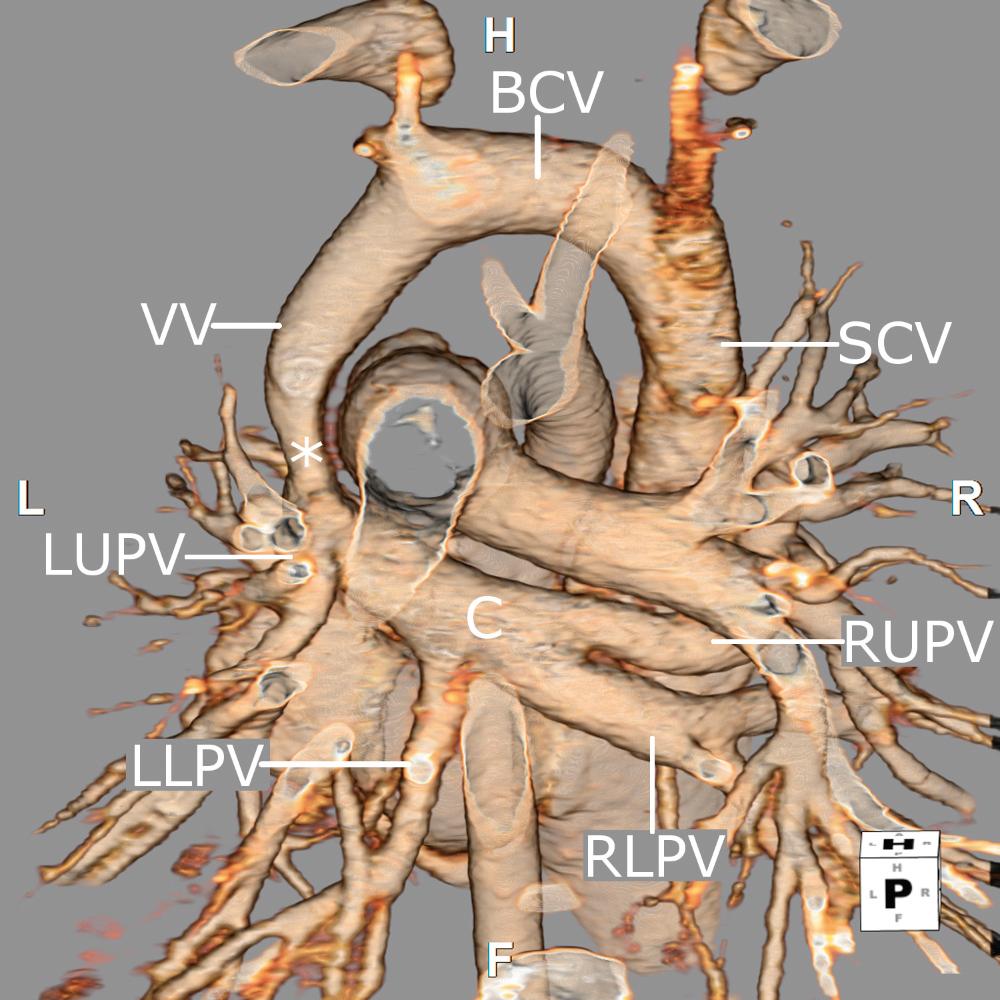
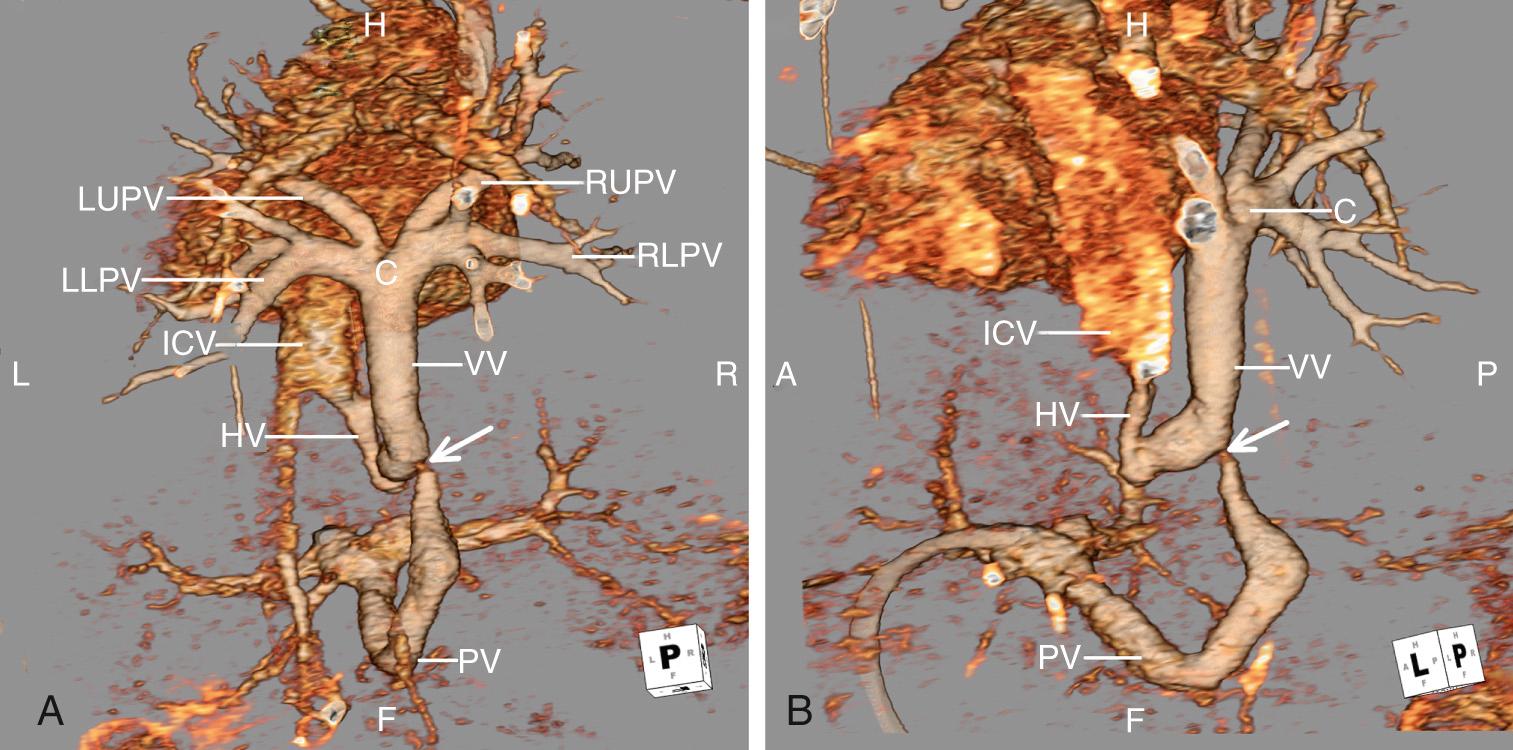
Much of the basis of differential diagnosis has already been discussed and will not be repeated here. As we shall see, pulmonary venous atresia also presents as totally anomalous connection with severe pulmonary venous obstruction. The two conditions, however, may be indistinguishable prior to surgery if no common pulmonary vein is seen by preoperative imaging.
Unobstructed connection has to be distinguished from other conditions producing heart failure, mild cyanosis, and cardiomegaly with pulmonary plethora and right ventricular hypertrophy. The most important of these is complete transposition with large ventricular septal defect, in which the second heart sound is commonly single. Atrioventricular septal defect with common atrium is easily distinguished by echocardiography. Totally anomalous connection to the left vertical vein must be distinguished from the levoatrial cardinal vein found in association with mitral atresia and intact atrial septum (see later). In both conditions, pulmonary venous blood flow is to a confluence via a left vertical vein. In the case of the levoatrial cardinal vein, the confluence is the left atrium, the pulmonary veins being normally connected.
With medical treatment alone, 75% of all children with TAPVC uncomplicated by isomerism had died or required surgery before their first birthday. It is of interest that this poor survival occurred despite the fact that less than 10% had infradiaphragmatic anomalous connection. In one study of 25 patients with pulmonary venous obstruction treated medically, only two survived their first year. In the postmortem study from central Bohemia, which relates to the time before advanced cardiac surgery, 95.8% of deaths occurred in the first year of life. For definitive management, surgical repair is required.
Medical management consists of supportive measures in preparation for definitive surgical management. With unobstructed TAPVC, medical management is aimed at optimizing right heart failure and hypoxia. In obstructed TAPVC, medical management is directed at correcting hemodynamic compromise and metabolic acidosis. Neonates are typically ventilated and prostaglandin E1 may temporarily improve systemic cardiac output by maintaining a right-to-left shunt through the ductus arteriosus; however, this maneuver is unlikely to offer significant resuscitation in a hypoxic neonate with poor hemodynamics.
Although the diagnosis of TAPVC is an absolute indication for surgical intervention, owing to the clinical spectrum of presenting physiology in children with TAPVC, there are temporizing measures that can be used to bridge a child to surgery, particularly those children that are of low birth weight and presenting with severe hemodynamic compromise.
Balloon atrial septostomy has been used to relieve a restrictive interatrial defect with limited improvement in systemic hemodynamics. Sano and colleagues found that septostomy did not result in sufficient clinical improvement in critically ill patients to permit deferral of surgical repair.
In patients with obstructed pulmonary venous return, a hybrid approach with endovascular stent placement can be considered as a bridge to surgery. This approach palliates cardiogenic shock and allows for optimization of preoperative status. Case reports have documented the successful stenting of the obstructed vertical vein, with infracardiac and supracardiac types of TAPVC being the most commonly reported. Case reports document primary stenting with angioplasty for in-stent restenosis leading to subsequent surgical repair, with the longest interval between stenting and surgery documented as 15 months. There is also documentation of stent placement between the pulmonary confluence and the left atrium to bridge a neonate to surgery.
For children who present with obstructed TAPVC and cardiogenic shock, ECMO can be an effective bridge to surgery. Case reports document ECMO being used to stabilize prior to endovascular stent placement and/or surgery. ECMO is also used postoperatively in approximately 8% of children requiring TAPVC repair in the Society for Thoracic Surgeons database, with the majority of these patients having single-ventricle physiology.
The timing of surgery is influenced by the clinical status of the presenting child. In neonates with obstructed TAPVC, prompt definitive surgical repair is essential. For children with unobstructed TAPVC, the timing of elective repair is less clear. Some centers opt for early elective neonatal repair, whereas others delay elective repair until 3 to 6 months of age. As neonatal surgery has advanced and surgical mortality is low, advocates of early elective neonatal repair feel that the abnormal circulation's effect on the ventricle and potential increased need for mechanical ventilation in the postoperative period suggest that early surgical intervention is beneficial. Other centers delay elective surgical repair on the unproven assumption that surgical risk and neurodevelopmental outcomes are more favorable by avoidance of the neonatal period.
TAPVC was the first condition that necessitated open heart repair, given the lack of palliative options and potential for excellent long-term results if immediate survival could be achieved. The results from the early surgical series demonstrate high mortality in infants undergoing repair. Operations at this time included those in which an anastomosis between the pulmonary venous confluence and the left atrium was created but the interatrial communication was not closed; the vertical vein, if obstructed, was not ligated. Although subsequent spontaneous closure of the interatrial communication was documented in some patients, this staged approach is now rarely used and surgical results have now greatly improved. In the early 1980s, patient age or site of connection was debated as the most important determinant of operative survival, but most recent studies have not shown either to be significant in routine repairs. Surgical mortality in the current era can be less than 5% in those with isolated disease, making the analysis of risk factors for perioperative mortality challenging.
Preoperative risk factors of death include preoperative pulmonary venous obstruction, functional univentricular physiology, and factors associated with early age of repair. Preoperative hemodynamic factors such as higher pulmonary artery systolic pressure, use of preoperative inotropic agents, and postoperative events related to pulmonary hypertension are important risk factors for surgical mortality. The type of cardiac connection has been identified in some series as an important factor associated with death, with infracardiac and mixed types being associated with higher risk. As many of the preoperative determinants are related to unstable hemodynamics in the preoperative period, outcomes in subsets of patients will likely improve with prenatal diagnosis and the use of temporizing measures such as endovascular stent placement and ECMO.
Surgical repair is dictated by the underlying anatomy; however, all surgical approaches have the common goal of creating the largest possible opening between the pulmonary vein confluence and the left atrium.
Cardiac TAPVC repair typically involves the unroofing of the coronary sinus connected to the vertical vein. After cardioplegic arrest, the right atrium is entered and the common wall between the coronary sinus and the connecting vein is incised back to the pulmonary venous confluence, creating a wide confluence. The coronary sinus and atrial septal defect are closed with a pericardial patch, which leaves the pulmonary venous effluent and the coronary sinus blood draining to the left atrium. In instances where the pulmonary veins attach to the right atrium, a baffle is created to direct the returning blood to the left atrium, in a manner similar to superior sinus venosus atrial septal defects with partial anomalous pulmonary venous connection.
In supracardiac and infracardiac TAPVC repair, the pulmonary venous confluence can be accessed from the right or the left side. In the left-sided approach, the heart can be retracted anteriorly and rightward to expose the pulmonary venous confluence. Corresponding incisions are made in the pulmonary venous confluence and the left atrium and an anastomosis is constructed between the divided structures ( ). Care must be taken to ensure that the rightward retraction of the heart does not result in distortion of the anastomosis when the heart is returned to its anatomic position. Alternatively, in the right-sided approach, the pulmonary vein confluence is accessed through the right atrium, through the atrial septum, and through an incision in the posterior wall of the left atrium. The pulmonary vein confluence is incised and anastomosed to the left atrium. The divided atrial septum is often closed with a pericardial patch, which also serves to enlarge the overall size of the left atrium.
Mixed TAPVC repair is dictated by the underlying anatomy, with the most common anatomy being where one vein remains connected to the systemic venous circulation while the other three veins drain into a posterior confluence. With this arrangement, the confluence is anastomosed to the posterior left atrium and the solitary vein is reimplanted or incorporated into larger confluence anastomosis using a sutureless technique (described later). In some cases a single pulmonary vein can remain connected to the systemic venous circulation, resulting in a small residual left-to-right shunt that does not affect the overall hemodynamics.
The sutureless technique was introduced in 1996 by two groups and was developed to address PVS, which arose after repair of TAPVC (postrepair PVS). Initial early and midterm results suggested encouraging freedom from recurrent stenosis. The use of the sutureless technique has been extended as a primary repair technique for TAPVC and as a prophylactic strategy to minimize postrepair PVS; midterm single-institution cohorts have demonstrated noninferiority of this technique when compared with conventional repair. The sutureless technique utilizes resection of obstructed pulmonary veins and direct suturing of the left atrium to the pericardium around the divided pulmonary vein confluence, avoiding direct suturing of the left atrium to the pulmonary veins. The main theoretical advantages derived from the sutureless technique include maximizing the confluence size, minimizing distortion, avoiding suture-related trauma to the incised pulmonary vein tissue, avoiding circulatory arrest, and diminished geometric complexity in comparison to conventional repairs. Encouraging midterm results have been seen in small series of high-risk groups such as children with infracardiac and mixed TAPVC, a small confluence, or preoperative pulmonary vein obstruction. A large retrospective study has found that the sutureless technique is associated with a lower rate of postrepair PVS than conventional repair. Although evidence supports the use of sutureless techniques, prospective trials have not been undertaken owing to prohibitive sample size requirements.
The vertical vein is often ligated at the time of surgery. Some surgeons elect to leave it open as a mechanism to decompress elevated left atrial pressures in patients in whom the left heart has difficulty tolerating an acute increase in pulmonary venous return after surgery. In this respect, the patent vertical vein has the same physiologic effect as an atrial septal defect, and this can be beneficial in the management of postoperative pulmonary hypertension. After repair, flow through this high-resistance pathway is thought to be negligible, although a follow-up study on these patients suggests that this vein often remains patent. Intraoperatively, the surgeon can guide decision making by measuring the left atrial and systemic arterial pressures after the patient is taken off bypass. If snaring of the vertical vein is achieved without a rise in left atrial pressure and a fall in systemic pressure, ligation of the vein is performed. Case reports have demonstrated delayed closure of the vertical vein with percutaneous devices for those children who develop significant left-to-right shunts postoperatively.
The late results of surgical repair of total anomalous pulmonary venous connection are generally excellent. The hazard function for death becomes similar to that of the general population within about 24 months of operation. Nonetheless, late pulmonary venous obstruction (postrepair PVS) occurred in about 10% of all large surgical series, and this has remained relatively constant over the last 30 years. This serious complication is poorly understood and can occur in patients with and without obstruction prior to surgery.
Factors associated with poor surgical outcomes include infracardiac or mixed drainage, repairs made at a younger age, and complex congenital cardiac lesions (i.e., single-ventricle physiology). Importantly, postrepair PVS and preoperative pulmonary venous obstruction are also associated with increased risk of death. Patients with a small pulmonary venous confluence and residual gradients in the pulmonary veins following repair are at risk of developing postrepair PVS.
Become a Clinical Tree membership for Full access and enjoy Unlimited articles
If you are a member. Log in here